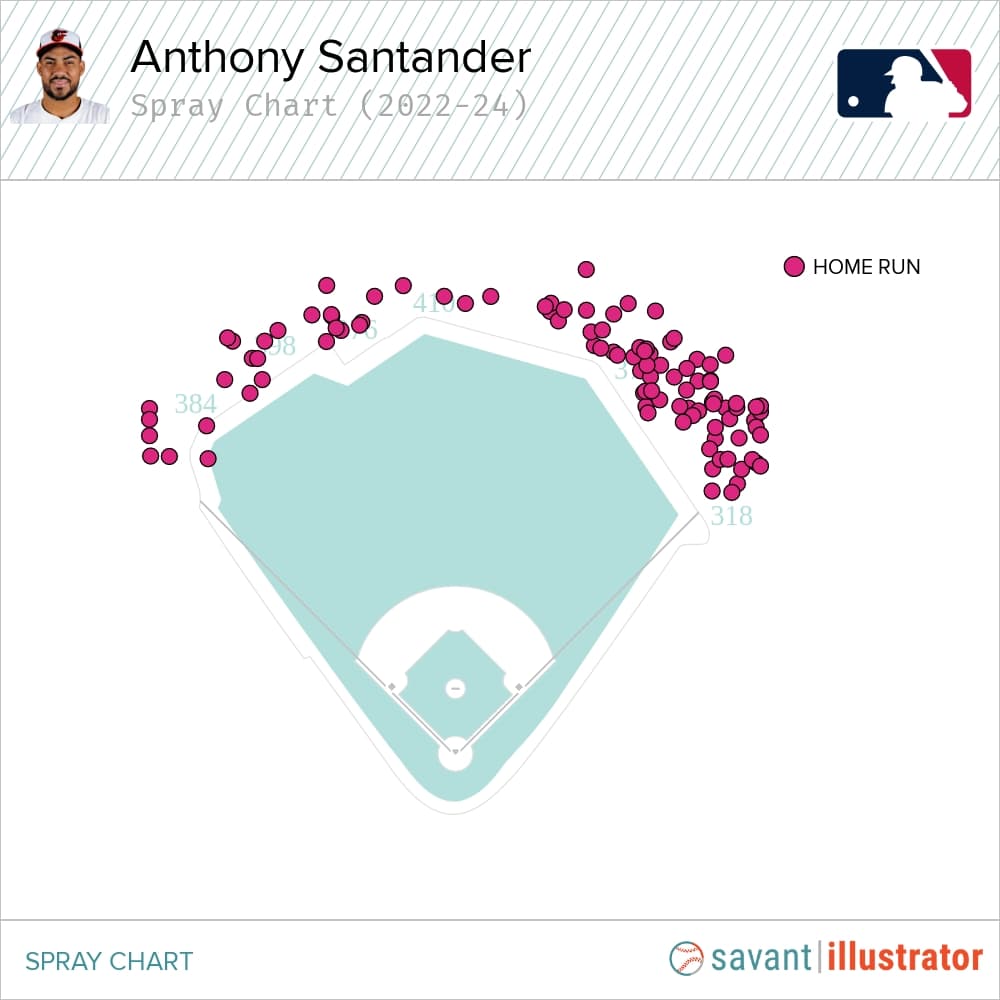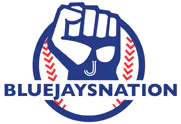Only José Ramírez (179) & Marcus Semien (207) have pulled more FBs than Anthony Santander (172) since '22. Paired with his slightly above-average quality of contact metrics, odds are he'll likely continue to outperform his expected results. #BlueJays
Blue Jays are taking worthwhile risk with Anthony Santander’s five-year deal

Photo credit: © Tommy Gilligan - USA Today
By Thomas Hall
Jan 21, 2025, 14:30 ESTUpdated: Jan 21, 2025, 15:02 EST
Monday’s signing of switch-hitter Anthony Santander marked an important first step for the Toronto Blue Jays, who badly needed a win in free agency, arguably more than any other franchise in the sport.
The organization has since recovered after fumbling the events leading up to Roki Sasaki’s decision to sign with the Los Angeles Dodgers last Friday. They may not be able to undo the mistake of absorbing nearly $12 million of Myles Straw’s remaining contract. But, the positive news is that doing so didn’t prevent them from making their first significant offensive addition of the off-season.
Acquiring Santander directly addresses Toronto’s need for some middle-of-the-order thump, considering he’s coming off a career year where he blasted 44 home runs, slugged .506 and was a three-win player in 155 games with the Baltimore Orioles — all career-highs, excluding 2020. He was also 29 per cent above a league-average hitter, per his 129 wRC+ (100 league average).
It’s exactly the type of transaction the Blue Jays had to make this winter. Granted, the front office needed to soar above most teams’ comfort zones to sign the 30-year-old slugger, offering him a fifth guaranteed season — which he was reportedly seeking for most of this off-season — for the deal to reach the finish line.
Agreeing to those terms is a calculated risk for Toronto, a gamble that has the potential to backfire during the second half of Santander’s contract. This team is betting on someone who didn’t put it all together until a few years ago, is now 30, doesn’t earn many walks and has outperformed his expected results over the previous two seasons.
However, even with the concerns associated with the length of his five-year deal, it’s certainly a risk worth taking.
Simply put, the Blue Jays couldn’t afford to miss out on a hitter who matches their offensive needs as perfectly as Santander. Plus, they must maximize their chances of returning to a competitive state in 2025, especially due to Vladimir Guerrero Jr. and Bo Bichette’s uncertain futures as pending free agents, and the former O’s masher should be able to help stir this ship in the right direction.
In an ideal world, management probably would have preferred to ink Santander to a three or four-year contract, thus minimizing their potential exposure to a performance decline in future seasons. On the other hand, tacking on a fifth guaranteed year may have increased the club’s level of risk involved, but it’s also left them valuable flexibility for additional spending.
Before accounting for salary deferrals, Santander’s average annual value on his $92.5-million contract would’ve added $18.5 million per season to Toronto’s payroll through 2029 — a very reasonable price tag for a player of his calibre. But with a significant portion of his deal expected to be deferred, as Sportsnet’s Ben Nicholson-Smith reports, that’ll drop his AAV into the $14 million range, presenting as a considerable bargain compared to the prices other free-agent outfielders/DH types have received this winter.
Years | Total Value | AAV | |
Teoscar Hernández* | 3 | $66 million | $20.94 million |
Joc Pederson | 2 | $37 million | $18.5 million |
Michael Conforto | 1 | $17 million | $17 million |
Tyler O’Neill | 3 | $49.5 million | $16.5 million |
*Dodgers deferred $23.5 million of Hernández’s $66-million contract*
If you polled the baseball community at the start of this off-season, most, if not all, would’ve surely predicted that Santander would command at least $20 million per season and finish near the top of this chart alongside Hernández. So, having his AAV rank lower than all four of those listed above should be considered a huge victory for Toronto’s brass.
Trading longer term for a lower AAV should provide the Blue Jays with immense value regarding Santander’s contract, at least across the first few seasons. It also has a financial benefit, bringing their projected Competitive Balance Tax (CBT) payroll back below the second luxury tax threshold of $261 million, savings they’ll be able to use elsewhere in free agency — like on another impact hitter, perhaps.
Now that we’ve covered the financial logistics of this signing, let’s move on to the player himself and explore how his offensive profile may age more gracefully than most anticipate.
Santander doesn’t rely on generating high amounts of hard contact like many of baseball’s premier home-run hitters do. Instead, he compensates for his slightly above-average quality-of-contact metrics (60th-percentile hard-hit rate in 2024) with his batted-ball output, focusing on pulling as many fly balls as possible — third-most (172) of anyone since ’22.
That’s caused the native of Venezuela to outperform his expected metrics in recent seasons, resulting in a .053 gap between his SLG and xSLG since ’23 — the fifth-highest among 113 qualified big-league hitters (min. 1,000 plate appearances), trailing the likes of Jose Altuve, Cody Bellinger, Jeimer Candelario and Isaac Paredes.
It’s no secret that Santander performs at his best when he elevates the ball, as he posted a 1.039 SLG, .887 xSLG, 48.4-per-cent hard-hit rate, 27-per-cent barrel rate and a plus-29 run value — tied with Philadelphia’s Bryce Harper for 12th-highest in the majors — against fly balls last season.
If he continues producing elite fly-ball rates (career-high 54.8 per cent in 2024), depositing over a third to the pull side from either side of the plate, it should bode well toward sustaining his favourable batted-ball fortune. As such, we may have to become accustomed to his traditional results outperforming his expected ones from year to year.

Source: Baseball Savant
Looking ahead to next season, the addition of Santander finally addresses the protection — or lack thereof — this lineup has provided behind Guerrero in the two seasons since trading Hernández to the Seattle Mariners.
Without the three-time Silver Slugger, the Blue Jays have struggled mightily to receive consistent production from the clean-up spot, hitting the fewest home runs (31) in baseball from that position. Even the Chicago White Sox have produced more during that span, ranking 26th with 40.
Additionally, Toronto’s collective No. 4 hitters registered a measly .387 SLG, good for 28th in the sport, ahead of only the New York Yankees (.375) and Los Angeles Angels (.360).
Lineup combinations are dramatically altered throughout the course of a 162-game schedule. But, having one constant of Guerrero and Santander hitting back-to-back, is a major improvement over every configuration from the previous two campaigns.
Santander improves the Blue Jays lineup in many ways, another of which will be how they fare versus pitchers with high changeup usages next season. The offence stumbled out of the gate against that pitch type a season ago and ultimately placed 17th in SLG (.367) and 22nd in run value (+1) throughout the majors.
Meanwhile, Santander has been among the sport’s most productive hitters against changeups since his breakout 2022 campaign, and only three other hitters have faced more than him (8,120) in that span — Ian Happ (8,155), Francisco Lindor (8,283) and Juan Soto (8,622).
HR (MLB Rank) | SLG | xSLG | K% | Whiff% | Hard-Hit% | Barrel% | Run Value | |
Anthony Santander (2022-24) | 16 (2nd) | .457 (4th) | .472 (T-3rd) | 15.2% (8th) | 21.7% (T-6th) | 41.8% (T-4th) | 8.6% (4th) | 17 (3rd) |
The 6-foot-2 switch-hitter should also provide support versus high-velo fastballs (95 m.p.h. or higher), recording a .453 SLG and plus-nine run value since 2022. In comparison, Toronto’s offence proved susceptible to those explosive offerings last season, ranking 28th industry-wide in both SLG (.338) and run value (-43).
Now that the Blue Jays have landed Santander, where they turn next becomes incredibly vital. Reducing the veteran slugger’s AAV with a five-year term and deferrals — a first for this franchise — was a savvy piece of business, but only if management continues adding to the roster with meaningful acquisitions.
General manager Ross Atkins needs to procure another impact hitter this off-season, whether it’s via free agency or trade, to significantly raise the ceiling of next season’s offence. Signing Pete Alonso or Jurickson Profar would certainly check that box, as would packaging together a few controllable infielders from the organization’s surplus for a bat-first outfielder or DH type.
The pitching staff still requires work, too, especially the starting rotation. With those needs in mind, signing Santander has to be a building block that helps set up the rest of this winter for Toronto, which has less than a month to conclude its roster construction before spring training arrives.
